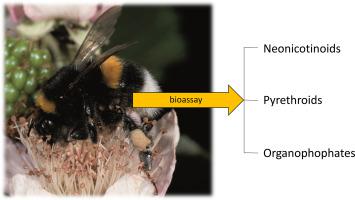当前位置:
X-MOL 学术
›
Pestic. Biochem. Phys.
›
论文详情
Our official English website, www.x-mol.net, welcomes your
feedback! (Note: you will need to create a separate account there.)
Assessing the acute toxicity of insecticides to the buff-tailed bumblebee (Bombus terrestris audax)
Pesticide Biochemistry and Physiology ( IF 4.2 ) Pub Date : 2020-06-01 , DOI: 10.1016/j.pestbp.2020.104562 Rebecca J Reid 1 , Bartlomiej J Troczka 2 , Laura Kor 1 , Emma Randall 2 , Martin S Williamson 1 , Linda M Field 1 , Ralf Nauen 3 , Chris Bass 2 , T G Emyr Davies 1
Pesticide Biochemistry and Physiology ( IF 4.2 ) Pub Date : 2020-06-01 , DOI: 10.1016/j.pestbp.2020.104562 Rebecca J Reid 1 , Bartlomiej J Troczka 2 , Laura Kor 1 , Emma Randall 2 , Martin S Williamson 1 , Linda M Field 1 , Ralf Nauen 3 , Chris Bass 2 , T G Emyr Davies 1
Affiliation

|
The buff-tailed bumblebee, Bombus terrestris audax is an important pollinator within both landscape ecosystems and agricultural crops. During their lifetime bumblebees are regularly challenged by various environmental stressors including insecticides. Historically the honey bee (Apis mellifera spp.) has been used as an ‘indicator’ species for ‘standard’ ecotoxicological testing, but it has been suggested that it is not always a good proxy for other eusocial or solitary bees. To investigate this, the susceptibility of B. terrestris to selected pesticides within the neonicotinoid, pyrethroid and organophosphate classes was examined using acute insecticide bioassays. Acute oral and topical LD50 values for B. terrestris against these insecticides were broadly consistent with published results for A. mellifera. For the neonicotinoids, imidacloprid was highly toxic, but thiacloprid and acetamiprid were practically non-toxic. For pyrethroids, deltamethrin was highly toxic, but tau-fluvalinate only slightly toxic. For the organophosphates, chlorpyrifos was highly toxic, but coumaphos practically non-toxic. Bioassays using insecticides with common synergists enhanced the sensitivity of B. terrestris to several insecticides, suggesting detoxification enzymes may provide a level of protection against these compounds. The sensitivity of B. terrestris to compounds within three different insecticide classes is similar to that reported for honey bees, with marked variation in sensitivity to different insecticides within the same insecticide class observed in both species. This finding highlights the need to consider each compound within an insecticide class in isolation rather than extrapolating between different insecticides in the same class or sharing the same mode of action.
中文翻译:

评估杀虫剂对黄尾大黄蜂(Bombus terrestris audax)的急性毒性
黄尾大黄蜂 Bombus terrestris audax 是景观生态系统和农作物中的重要传粉者。大黄蜂在其一生中经常受到包括杀虫剂在内的各种环境压力的挑战。历史上,蜜蜂(Apis mellifera spp.)一直被用作“标准”生态毒理学测试的“指示”物种,但有人认为它并不总是其他群居或独居蜜蜂的良好替代品。为了研究这一点,使用急性杀虫剂生物测定法检查了土生小蠹对新烟碱类、拟除虫菊酯类和有机磷酸酯类中选定农药的敏感性。 B. terrestris 对这些杀虫剂的急性口服和局部 LD50 值与已发表的 A. mellifera 结果大致一致。对于新烟碱类杀虫剂,吡虫啉具有剧毒,但噻虫啉和啶虫脒几乎无毒。对于拟除虫菊酯类,溴氰菊酯具有高毒性,而t-氟氰菊酯只有轻微毒性。对于有机磷酸盐,毒死蜱具有剧毒,但蝇毒磷几乎无毒。使用杀虫剂和常见增效剂进行的生物测定增强了 B. terrestris 对几种杀虫剂的敏感性,表明解毒酶可能提供一定程度的针对这些化合物的保护。 B. terrestris 对三种不同杀虫剂类别中的化合物的敏感性与报道的蜜蜂相似,在这两个物种中观察到对同一杀虫剂类别中不同杀虫剂的敏感性存在显着差异。这一发现强调需要单独考虑杀虫剂类别中的每种化合物,而不是在同一类别的不同杀虫剂之间进行推断或具有相同的作用模式。
更新日期:2020-06-01
中文翻译:

评估杀虫剂对黄尾大黄蜂(Bombus terrestris audax)的急性毒性
黄尾大黄蜂 Bombus terrestris audax 是景观生态系统和农作物中的重要传粉者。大黄蜂在其一生中经常受到包括杀虫剂在内的各种环境压力的挑战。历史上,蜜蜂(Apis mellifera spp.)一直被用作“标准”生态毒理学测试的“指示”物种,但有人认为它并不总是其他群居或独居蜜蜂的良好替代品。为了研究这一点,使用急性杀虫剂生物测定法检查了土生小蠹对新烟碱类、拟除虫菊酯类和有机磷酸酯类中选定农药的敏感性。 B. terrestris 对这些杀虫剂的急性口服和局部 LD50 值与已发表的 A. mellifera 结果大致一致。对于新烟碱类杀虫剂,吡虫啉具有剧毒,但噻虫啉和啶虫脒几乎无毒。对于拟除虫菊酯类,溴氰菊酯具有高毒性,而t-氟氰菊酯只有轻微毒性。对于有机磷酸盐,毒死蜱具有剧毒,但蝇毒磷几乎无毒。使用杀虫剂和常见增效剂进行的生物测定增强了 B. terrestris 对几种杀虫剂的敏感性,表明解毒酶可能提供一定程度的针对这些化合物的保护。 B. terrestris 对三种不同杀虫剂类别中的化合物的敏感性与报道的蜜蜂相似,在这两个物种中观察到对同一杀虫剂类别中不同杀虫剂的敏感性存在显着差异。这一发现强调需要单独考虑杀虫剂类别中的每种化合物,而不是在同一类别的不同杀虫剂之间进行推断或具有相同的作用模式。











































 京公网安备 11010802027423号
京公网安备 11010802027423号